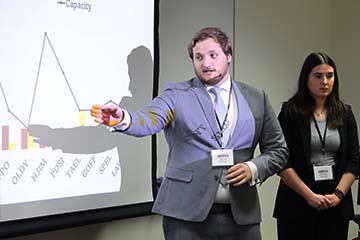Don’t be haunted by application fees! Undergraduate students can apply for free all month long.
Apply NowWhy can you see the Northern Lights in Michigan?
Brooks Observatory director explains the phenomenon behind the Northern Lights
The Northern Lights, known more technically as the Aurora Borealis, are a spectacular sight in the night sky. While typically visible only in the far north, occasionally they are strong enough that you can see them in mid-Michigan.
Aaron LaCluyzé is a member of Central Michigan University’s physics faculty. He shared his expertise on what causes the Northern Lights and whether you can expect more opportunities to see them in the next year.
Q. How is the sun related to the Northern Lights?
The Northern Lights, the glowing, shimmering colors in the nighttime sky, happen because energetic particles streaming off of the Sun interact with the upper atmosphere of Earth. Charged particles stream off the Sun constantly and make up what astronomers call the “solar wind.” The Sun is about 93 million miles from Earth, but these particles are travelling at tens of millions of miles per hour, so they arrive just a few days after leaving the Sun.
Q. How do those particles from the Sun interact with the Earth’s atmosphere?
When these particles arrive at Earth, they are mostly deflected around the us by the Earth’s magnetic field and continue onward away from the Sun. Some of those particles are instead caught up in our magnetic field and driven towards the north and south poles where they slam into the upper atmosphere. When this happens, the gasses that make up the atmosphere are struck by these fast-moving energetic particles causing a glow, similar to how a fluorescent light bulb works. The colors that you see in the aurora are due to the different kinds of gasses that make up our atmosphere; reds are typically from oxygen, greens come from oxygen or nitrogen, etc. The exact reactions can get a bit complicated, so I am simplifying a bit here, but hopefully that explains the general idea.
Q. Can this be dangerous to aircraft or satellites?
The aurora themselves are not dangerous to people or animals, but the charged particles from space that cause the aurora can be problematic for the electronics systems on satellites and high-flying aircraft. Most passenger aircraft don’t fly high enough for it to be a problem and most satellites are hardened against all but the most energetic hits, so it isn’t normally a problem. That being said, if the Sun were to have an exceptionally large outburst it might even affect some of the electrical grid or our computer infrastructure. This is why it is so important for scientists to continue to study the Sun and the aurora.
Q. Are the Northern Lights becoming more frequently visible further south?
Typically, the solar wind is relatively calm so resulting light show is only visible if you happen to live quite far north or south on the globe. The Sun does go through cycles where it is more or less active over time, so the resulting solar wind, and therefore the aurora, can be stronger or weaker. The Sun is currently in a very active state, so the solar wind is stronger right now. When this happens, the aurora can be much brighter and may be visible much further south than normal. During an exceptional auroral display they may be visible as far south as Texas, but this is very uncommon. Here in Michigan, we are just slightly too far south for aurora to extremely common, but when the Sun is as active as it is now, our chances of seeing them are greatly increased.
Q. How long is this expected to last?
The solar cycle lasts about 11 years, and we are currently nearing a peak of solar activity. This cycle isn’t perfectly regular, so while the next peak was initially expected around 2025, based on the Sun’s activity it may peak a bit sooner than that, likely sometime in 2024 with decreasing activity for the next several years after that.
But keep in mind that the Sun can be very unpredictable! Even after we pass the peak of activity, the Sun might have a sudden outburst leading to increased aurora. It is always a good idea to keep an eye on the sky to the north any time you have a clear night away from city lights, but you can also check out some online sites like the NOAA Aurora Dashboard or Spaceweather if you want to increase your chances of seeing aurora for yourself.
About Aaron LaCluyzé





